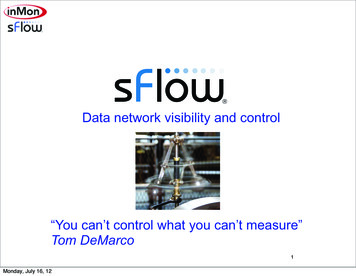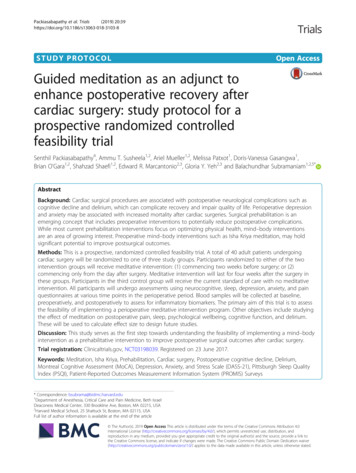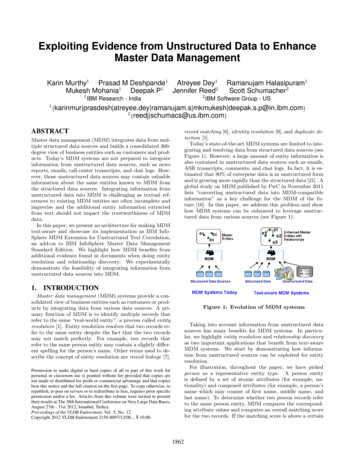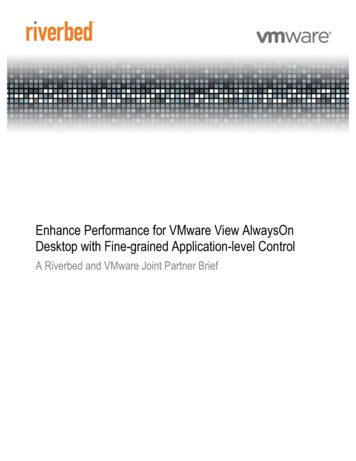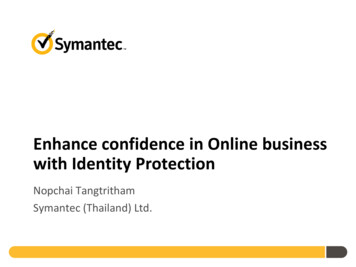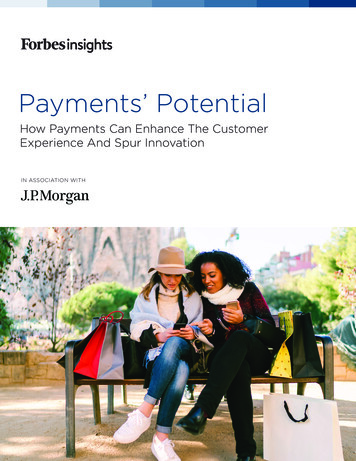
Transcription
Payments’ PotentialHow Payments Can Enhance The CustomerExperience And Spur InnovationIN ASSOCIATION WITH 2020 FORBES INSIGHTS 1
The convergence of commerce and technology is transforming the way the world creates,exchanges and protects value.In Payments Potential: How Payments Can Enhance the Customer Experience and Spur Innovation,Forbes and J.P. Morgan share unique findings from a survey of 300 global executives and insightinto ways businesses can: Provide more seamless and frictionless customer experiences Use data insights to balance revenue optimization and fraud mitigation priorities Maintain a competitive edge by remaining agile and digitally empowered Access consumers and grow revenue in the world’s most important marketsProviding insight and perspective into the technological, financial, regulatory and market forcesthat are redefining global commerce represents J.P. Morgan’s commitment to our clients’ near- andlong-term success.We see a world of opportunity and look forward to helping our clients continue to grow wallet andmarket share with unprecedented speed, agility and security.With best regards,Laura MillerPresident, J.P. Morgan Merchant ServicesJ.P. Morgan is a marketing name for certain businesses segments of JPMorgan Chase & Co. and its subsidiaries worldwide. The material contained herein or in any relatedpresentation or oral briefing do not constitute in any way J.P. Morgan research or a J.P. Morgan report, and should not be treated as such (and may differ from thatcontained in J.P. Morgan research) and are not intended as an offer or solicitation for the purchase or sale of any financial product or a commitment by J.P. Morgan as tothe availability to any person of any such product at any time. All J.P. Morgan products, services, or arrangements are subject to applicable laws and regulations, itspolicies and procedures and its service terms, and not all such products and services are available in all geographic areas.jpmorgan.com/merchant-services
Table Of Contents5Introduction6What Do Customers Want?9Payments’ Untapped Potential12The Evolutionary Bottleneck17Going Global: Meeting LocalExpectations19Conclusion20214 MethodologyAcknowledgmentsPAYMENTS’ POTENTIAL How Payments Can Enhance The Customer Experience And Spur Innovation
IntroductionCustomers want a multichannel experiencewhere they can make the right paymentat the right time and in the way that bestsuits their business or lifestyle.Once viewed simply as a transaction, payments have evolvedinto an important component of the customer experience, arevenue-generating business model and a primary way ofboosting efficiency. But with this new mandate come immenseopportunities: Companies that understand the paradigm shiftbetter than their peers stand to gain a competitive edge.85% of survey respondentssay payment methods areimportant to provide the bestpossible customer experienceWith customers seeking to buy what they want, from the channel they prefer, when they want—and have it delivered to theirdesired location—companies are being measured on theirThis report shares insights regarding:ability to provide whatever-wherever-whenever experiences. What customers are looking for in paymentsThe customer wants each of these experiences to be smooth How data science can enhance security and accelerateand easy, but it’s anything but for the business that needs tobusiness growthdeliver them. In fact, to make experiences simple for their customers, companies need to take on more complexity and costs.Complexity doubles when companies try to provide their sup- Ways to deal with multiple business and payment modelspliers with the same experiences they provide their customers. The complexity of payments when expanding globallyIn a Forbes survey of more than 300 executives worldwide, justAs digital technology changes the way the world buys and pays,half say their company can deliver well on the overall customerexperience. However, the vast majority of them agree that payments are an integral part of the customer experience.businesses need partners that can help them unlock more strategic value from payments—from boosting revenue and profitability to optimizing customer experiences and global cashflow—while reducing the complexity that goes with providingpayments that meet customers’ expectations. 2020 FORBES INSIGHTS 5
What DoConsumers Want?Having established the importance of paymentsto the customer experience, we must now ask:What is the payment experience that consumers—and thus businesses—are looking for?Businesses want their end-to-end revenue cycle (paymentacceptance through reconciliation and posting) to be easy toexecute and manage and to be seamless.The survey reveals that speed and ease of use are the mostsought-after characteristics of payment systems. The rankingof what matters for businesses, with speed and ease on thetop and fees at the bottom, confirms a huge shift in howbusinesses view payments. They are no longer a commodity,when what mattered most was cost, but are rather a valuable,differentiating feature of the customer experience.Respondents chose three top characteristics of payment systemsEasy to use, quick, frictionless45%Stability38%Allows for use on multiple channels42%Ability to use internationally36%Allows for multiple payment options41%Tailored to customer preferences36%Security38%Low fees25%6 PAYMENTS’ POTENTIAL How Payments Can Enhance The Customer Experience And Spur Innovation
From One Industry To The Next,Priorities DifferMany of the world’s e-commerce companies are making the payment stage of the customer experience effectively invisible andthus painless. When payments are easy, customers are happy.They are not wasting their time on payment systems that do notwork and are not emotionally stressed about spending money.Payment becomes a natural extension of “ordering” a product orservice instead of being a glitch at the end of a purchase.The ride-sharing industry revolutionized payments when a popular ride-sharing service created invisible payments and was thefirst ground transportation company to put the payment in thebackdrop—and, in effect, make that its brand.Although the survey found some agreement among businessleaders around customer expectations, the payment experiencethat customers seek varies across industries. Retail, which to alarge degree pioneered the idea of customer experience, isa particularly complex payment landscape. For fast-movinggrocery stores, the most important factor is speed, which makesself-checkout and contactless payments a preferred solution. Atthe opposite end of the spectrum are luxury brands with discerning customers who may want to engage with a knowledgeablesales associate face-to-face. But part of that associate’s appeal isto be able to process payments, making the transaction part ofthe engagement.To create a multichannel experience, businesses need to offerthe ability to process payments anywhere the customer wants tobe, either physically or virtually. That can mean paying on theretailer’s e-commerce site or another online outlet, such as thecustomer’s social media feed, for example.Payment innovation in the transportation sector can be illustratedby Shell, which is meeting the needs of drivers with a brandedsmartphone app that allows consumers to pay and earn/userewards from the comfort of their vehicles at Shell-branded fuelstations in the United States. The Shell app provides numerouspayment options, including the ability to link to Shell-brandedcredit cards, checking accounts, Chase Pay and other mobile payment systems. The Shell app makes fueling faster, easier and morerewarding by allowing customers to link their Fuel Rewards account. In addition to processing Shell’s app payments, J.P. Morganprovides Shell with the opportunity to seamlessly engage morethan 60 million Chase cardholders, who receive valuable offers forfuel purchases when they activate Chase Pay in the Shell app. 2020 FORBES INSIGHTS 7
Businesses need payment solutions tobe customizable and flexible based ondemographics, industry, regulations, andlocal and global geography.The top attribute that respondents sayprovides a competitive advantage ispayments acceptance in all channels (69%):PerspectivesOn Payments“Successful adoption of new technologiesor solutions requires exceptional valuepropositions for customers. A growingnumber of customers today expect toshop, pay and send money anywhere,anytime, from any device—quickly andseamlessly,” according to a report fromOliver Wyman.1When payments are easy and invisible:“The best payment solution is whenwe remove it from the actual checkoutexperience,” says Ryan Sparks, head oftransformation and global expansion atJ.P. Morgan Merchant Services.When transaction speed doesn’tmeet expectations:“People would abandon transactionwhen the chip cards were too slow at thebeginning,” says Deborah Baxley, partnerat PayGility Advisors.1Making Payments Work for You: How Merchants Can OptimizePayments for Growth, Oliver Wyman, 20188 PAYMENTS’ POTENTIAL How Payments Can Enhance The Customer Experience And Spur Innovation
Payments’Untapped PotentialInsights from payment databoost business performanceUnlocking the potential of payment data requires theFor payment performance, J.P. Morgan takes a threefoldability to combine disparate acquiring and issuing dataapproach to delivering actionable insights. First, algorithmswith technology and deep data-science expertise that canmonitor payment data to detect anomalies. Then moni-transform data into actionable insights. Tony Wimmer,tored payment data is benchmarked against best-in-classhead of data and analytics at J.P. Morgan Wholesale Pay-performance levels. Finally, payment data is scanned forments, distinguishes between two different insights thatopportunities to enhance approval rates, processing costs,can be gleaned from payment data: payment insights andfraud mitigation and dispute resolution.consumer insights. Payment insights can help businesseswith retaining customers as well as efficiency, while con-Attention to such detail matters. When you consider thatsumer insights can help with growth.a J.P. Morgan client like Chevron processes more than 900million annual transactions in the United States, making sureIndustry-leading data scientists at J.P. Morgan have de-they can optimize payments has a huge impact for themveloped proprietary artificial intelligence algorithms thatoperationally and financially.scan payment data for actionable opportunities. “We aretaking the headache out of the day-to-day managementof this payment function,” says Wimmer. 2020 FORBES INSIGHTS 9
Consumer insights frompayment data spur growthHow is payment data being managed inyour organization?While using payment data for optimization keeps thebusiness engine running efficiently and retains customers,additional insights that can be gleaned from payment dataMostly separate from other datacan really rev it up.59%“By connecting acquiring and issuing data, we can helpmerchants grow their business by delivering valuable insights into customer behaviors. Merchants can be betterinformed about store location decisions and which cus-Integrated and managed with othercustomer and enterprise datatomer segments they have an opportunity to expand their39%reach and appeal with—relative to their peer group,” saysJ.P. Morgan’s Wimmer. “We also work with merchants toleverage payments data as an early warning system to trackmarket share and wallet share over time.”The relevance of payment data is growing. By 2025, theNot managed in our organization2%market data provider Statista estimates there will be 75billion connected devices worldwide—refrigerators that(Totals do not add to 100% due to rounding)restock themselves, cars that pay for gas and tolls, and soon—that will automatically generate payments, creating anexplosion of entry points into a business and generatingmasses of new customer and payment data.While there is incredible potential to tap into this data, J.P.Morgan’s first priority is always to safeguard the privacyof consumers and clients. “We only share insights that arederived from de-identified and highly aggregated datawith no references to specific individuals or businesses,”says Wimmer.To take advantage of what payment data offers, companiesmust ensure that data is organized and transparent. Inefficiencies in payments, such as poor visibility into cross-border payments and challenges of reconciliation, cannotpersist in a future in which digital payments are the norm.Companies are beginning to recognize that payment data isa missed opportunity. The top characteristic they are seeking in a payment solutions provider is the ability to help themuse the technology to access data and enhanced offerings.10 PAYMENTS’ POTENTIAL How Payments Can Enhance The Customer Experience And Spur Innovation
Data is referred to as the new oil—fuel thatcan accelerate business but only whenhandled carefully.When used in a de-identified and aggregated formatto meet with the highest privacy standards, paymentdata can provide businesses with valuable insights.Understanding payment data helps businesses balanceconsumers’ expectations for speed and convenience withthe company’s need to meet high security standards.These dual imperatives set a challenging goal forexecutives: to process as many transactions as possible—which requires speedy, frictionless, omnichannel solutionsand multiple payment methods—without compromisingsecurity and privacy.Financial institutions are vigilant about fraud whenapproving payments. The customer may have been hacked,had their card or identity stolen or not paid the bill, afterall. But from a statistical point of view, transaction declinesare often not warranted. Such “false positives” can lead toa one-time cart abandonment or even the permanent lossof a customer. Common false-positive scenarios includepurchases made while traveling, unusually high-dollar38%purchases and close proximity to credit limit. Keeping falsedeclines at bay is especially significant for businesses thatrely on monthly subscription fees.“As security has gotten stronger, false declines havegrown,” says Julie Fergerson, a member of the MerchantIssuer Committee at the Merchant Risk Council. “It’s areally huge problem for a lot of merchants, and they’relosing revenue over it.”At the heart of maintaining the right balance betweenPercentage of executives whosaid security will rank as thetop trend in payments overthe next three years.payment authorization and fraud prevention is theability to combine expertise in data science with a deepunderstanding of the payments industry. 2020 FORBES INSIGHTS 11
The EvolutionaryBottleneckUnderstanding the proliferation ofbusiness models and payment methodsAdvanced technologies have transformed the businessworld, enabling the introduction of new online and mobilebusiness models. The adoption of new models will furtherBusiness and delivery models thatbusinesses employ or are planningto employ within three yearsexplode with the broad implementation of 5G in the future.Among the surveyed business leaders, unattended checkoutis expected to be the most widely adopted new paymentexperience, followed by social commerce, which is the useof social networks in the context of e-commerce transac-Unattended checkout63%Social commerce61%tions. Ranked as the third most popular is dynamic pricing,or the practice of varying the price for a product or serviceto reflect changing market conditions, in particular charginga higher price at a time of greater demand.Dynamic pricing60%More than half of executives surveyed are either alreadyPlatforms/marketplace59%using most of these differentiating business models or expecting to do so within the next three years.Direct-to-consumerdelivery56%Click and collect55%47%Subscription servicesOnline groceryConnected homeConnected car12 PAYMENTS’ POTENTIAL How Payments Can Enhance The Customer Experience And Spur Innovation28%25%18%
Disruption in business modelsis disrupting paymentsThe business world has been disrupted by the technolo-The direct-to-consumer model is making inroads in thegy-driven business and delivery models. The success—healthcare sector as well, with the highest number ofeven survival—of companies and whole industries dependsexecutives representing healthcare service (73%) havingon whether they keep up. Consider how technology hasalready employed it or planning to employ it within threetransformed how people work, shop, watch television,years. The drivers of this business model in healthcarereceive healthcare, book vacations and travel.include consumer and payer acceptance of telemedicineand delivery-to-door services for prescriptions.Platform marketplaces, such as Amazon or eBay, haveby now become a ubiquitous business model, and haveWhile the idea of customer experience first gained traction inspurred a trend of manufacturers trying to build their ownthe business-to-consumer sector, the business-to-businessmarketplaces and sell directly to their customers. Thesector now also has to contend with customer expectations.direct-to-consumer model is gaining in popularity.Business-to-business sales are more complex as they entailbigger orders and multiple layers of financial approvals atThe subscription services model—considered among thethe buyer’s company. But business-to-business customersmost desirable by businesses, thanks to the promise ofare now expecting relevant business-to-consumer featuresrecurring revenue—is at this stage somewhat limited inas well. For instance, some business-to-business merchantsuptake by surveyed companies (47%), but only becauseare offering one-click payment approval.its applicability is limited by the type of industry, productor service. The administration of the subscription modelConnected commerce models, such as connected homealso calls for different types of data, customer and billingand car, may take longer to realize their full potential, withmanagement than the business-to-business or business-a quarter or less of survey respondents already employingto-consumer models.them or planning to do so within three years. However,once customers become more accustomed to voice as-The direct-to-consumer model stands out in how it viewssistants and self-driving cars, the ease and efficiency of athe importance of payments. The biggest group of di-connected car and home will make them a more popularrect-to-consumer executives believes that payments are anbusiness and delivery model.integral part of the customer experience. Since this modeloften involves commodity items—such as razors and toothbrushes—the convenience of the payment experiencehelps maintain customer loyalty.90%90% of direct-to-consumerexecutives believe thatpayments are an integral partof customer experience 2020 FORBES INSIGHTS 13
Payments are transitioning fromoperational necessity to strategic priorityCompanies cannot survive without competitive businessand delivery models, which, in turn, cannot function with-Which of the following payment methodsdo you currently offer? And which of thesepayment options are gaining in popularityamong your customers?out the right payment methods. Thus, regardless of business model, companies need to seamlessly embed rele-CurrentlyOfferGaining inPopularityDigital wallets46%27%Mobile-first payments45%19%Financing at checkout43%22%Contactless payments40%23%Mobile in-store36%16%Biometric authentication35%15%Unattended checkout32%14%Voice commerce/virtual assistance30%13%Tokenization30%11%vant payment methods into the customer experience,something that a quarter of survey respondents find challenging. Among the companies surveyed, different payment methods have been proliferating in addition to newbusiness models.J.P. Morgan’s Ryan Sparks calls the current stage of payments an “evolutionary bottleneck.” Different customerhabits and expec
J.P. Morgan Merchant Services. “People would abandon transaction when the chip cards were too slow at the beginning,” says Deborah Baxley, partner at PayGility Advisors. 1 Making Payments Work for You: How Merchants Can Optimize Payments for Growth, Oliver Wyman, 2018 Businesses need payment solutions to be customizable and flexible based on


